Spaghetti primavera (the word means “spring” in Italian) is a dish that conjures up images of green shoots in the Villa Borghese and warming southern sunshine in the Bay of Naples. In reality, though, its roots lie in the somewhat chillier ground of eastern Canada. Or so it’s claimed: the origins of this Italian-American classic are as hazy as a glass of col fondo prosecco, but whether chef Sirio Maccione, co-owner of New York’s infamous Le Cirque, really came up with it during a hunting trip to Prince Edward Island, as he told the New York Times, or whether it was his wife’s invention, as he claimed in his subsequent memoir, by 1977, spaghetti primavera was, according to that same newspaper, “by far the most talked-about dish in Manhattan”.
It wasn’t long before this “mad jumble of vegetables over pasta” (as Amanda Hesser described it in the same pages three decades later) had migrated to more casual red sauce joints all over the States – and then, just as abruptly, it fell from favour, as such madly fashionable dishes often do. You can’t even get a primavera at Olive Garden these days. Thankfully, however, you can still make it at home – and when you do, you’ll understand why it was so popular.
The vegetables
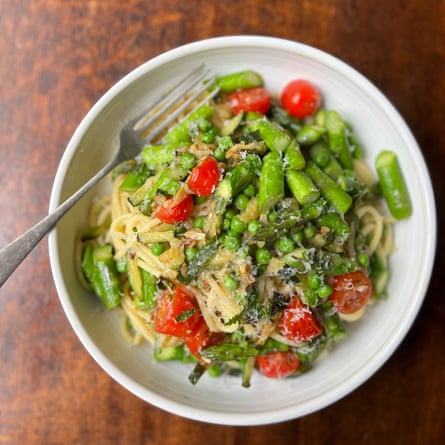
Sadly, I’ve never been to Prince Edward Island in spring, or at any other time of year for that matter, but as the average April temperature is a mere 7C, the variety of vegetables in Le Cirque’s recipe, including courgettes, tomatoes, broccoli, white mushrooms and green beans, as well as the asparagus and peas more readily associated with the season, comes as something of a surprise. Delicious magazine introduces a baby leek to the party, Giuliano Hazan a diced red pepper, and J Kenji López-Alt broccolini, broad beans and sugar snap peas, writing that: “To make a dish that screams spring, I decided to load mine up with all the green vegetables I could find.” Peas, asparagus, broad beans and spinach feel quite enough to me, but feel free to vary this according to what’s good near you.
Sauteed mushrooms, like the carrot, onion and celery soffritto base employed by both Delicious and Hazan, give the dish a richer, deeper flavour that feels more autumnal, while the sweet and sour fresh tomato sauce that Le Cirque dollops on top give it a summery air, as do the cherry tomatoes employed by Cook’s Country magazine. Spring tastes more delicate to me – it’s a time of fresh, green leaves and tender legumes, rather than anything so bold as a tomato or pepper.
Both Le Cirque and López-Alt blanch each vegetable separately in boiling water, while Hazan, Delicious and Cook’s Country fry them instead, with the former’s Classic Pasta Cookbook lamenting that, though “this recipe has become very popular outside Italy … unfortunately [it] is rarely executed properly. The most common mistake is not to saute the vegetables enough, which is what concentrates their flavour.” Loth as I am to disagree with Mr Hazan, blanched vegetables taste fresher – though I’m not keen on the crunchiness of some of the green beans and asparagus, which makes the Cook’s Country recipe, in particular, feel more like a warm pasta salad. Some of the mushiest vegetables I’ve enjoyed have been in Italy, and while that’s not the aim here, there’s no shame in cooking them through properly.
The seasoning
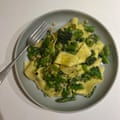
Soft herbs feel aptly delicate and springy; I like the cool perfume of Cook’s Country’s mint, with a little of Le Cirque and López-Alt’s basil to finish, but you could also use parsley or chives. Instead of a yellow onion base, I’ve gone for the fresher-flavoured spring onion, inspired by Melissa Clark’s recipe for the New York Times – I haven’t included garlic, because it has a tendency to mask more delicate ingredients, but if you can find the new season wet kind, you might like to stick a couple of finely chopped cloves in there, too. I don’t think the dish particularly benefits from chilli (fresh in Le Cirque’s case, dried in the Cook’s Country recipe), but I do like López-Alt’s lemon zest, which lifts the dish without overwhelming it.
The sauce
The Le Cirque recipe features a cream and chicken stock-based sauce, yet of the others I try, only Hazan retains the cream element; López-Alt writes that: “I know that pasta primavera is supposed to have a rich, cream-based sauce, but no matter how much I adjusted the ratios of cream and cheese, I couldn’t get over the fact that the bright spring vegetables felt smothered and muted when served with a creamy sauce.” He substitutes Clark’s creme fraiche (which, with its 40% fat content, compared with double cream’s 48%, hardly feels like a light option, unless you go for one of the inferior, more watery versions sold in this country under the same name), Delicious leaves out the dairy altogether in favour of a vegetable stock and white wine reduction, while Cook’s Country works magic with courgettes. “By overcooking zucchini,” they write in Big Flavors from Italian America, “we were able to create a silky sauce that nicely coated our favourite spring vegetables without cream or butter.” This is a brilliant idea in theory, but in practice, you’d have to stew courgettes for a lot longer, and in a lot more oil than their recipe allows for a really sauce-like consistency, and even then, pleasing as that would be, it would be quite different thing from cream.

And I like cream. It has a delicate sweetness that, far from muting the vegetables, allows them to shine while enriching the dish as a whole – spring is not high summer, after all, and a little richness is still welcome at this time of year. A spritz of lemon juice stops it weighing down the dish as so many seem to fear (though you could, of course, go for creme fraiche, if that appeals, in which case you may not need the lemon juice at all), while a splash of the pasta cooking water loosens it without the need for stock, which I do think would muddy the waters. Tangy, creamy and green are all the flavour notes this dish needs.
The pasta

Le Cirque calls for spaghetti, Hazan for the slightly thicker, flatter fettuccine (a shape that in my experience seems particularly popular in America) and Delicious for fettuccine or pappardelle. Like López-Alt, I prefer the texture of fresh egg pasta here, but, from a practical viewpoint, I don’t find that any of those shapes works perfectly with the vegetables, which tumble from the strands, making it a dish of two halves. For me, a pasta that will hold the vegetables, such as a shell or tube, is the better bet here, even though these tend to be available only dried. Feel free to use a long, fresh pasta if you prefer.
To finish
As well as the herbs mentioned above, Le Cirque and López-Alt add a final scattering of toasted pine nuts, whose nutty sweetness is a nice pairing with the lemon and cream, but strictly optional. Cheese, however, is mandatory – I prefer Cook’s Country’s saltier, tangier pecorino to the more usual, more richly flavoured parmesan, but either will be fine, as will a vegetarian alternative. Better than fine, in fact: it will be delicious.
Perfect pasta primavera
Prep 15 min
Cook 15 min
Serves 4
400g asparagus
Salt and black pepper
160g spinach, shredded if large
80g podded broad beans (frozen are fine)
80g shelled peas (frozen are fine)
400g pasta shells (conchiglie or conchiglioni, say), or tubes (rigatoni, penne, tortiglioni, etc)
40g pine nuts
75g butter
4 spring onions, chopped
160ml double cream
Zest and juice of ½ lemon
1 small bunch fresh mint
1 small bunch fresh basil
Pecorino romano, to finish
Bring a medium pan of water to a boil and put a colander in a clean sink of cold water (or fill a large bowl with cold water).
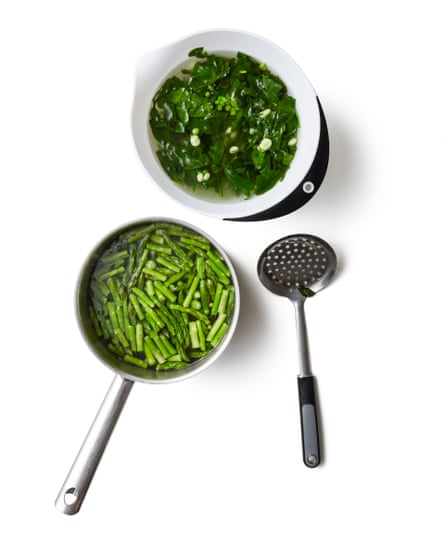
Snap the woody ends off the asparagus and cut the spears into short lengths. Salt the boiling water, then drop the spinach, beans and peas in the pan, blanch for a minute, then scoop out with a slotted spoon and refresh in the cold water. Cook the asparagus in the same pan for about four minutes, depending on its thickness, until just tender, then add to the rest of the blanched veg.
Bring a large pan of salted water to a boil for the pasta. Meanwhile, drain the vegetables and dry them on kitchen towel, squeezing out as much water from the spinach as possible. Peel the broad beans, unless they’re very young (or you’re not fussed).
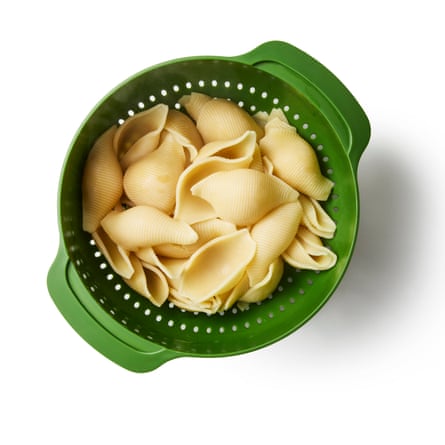
Put the pasta on to boil. Meanwhile, toast the pine nuts in a small pan until lightly golden, then set aside.
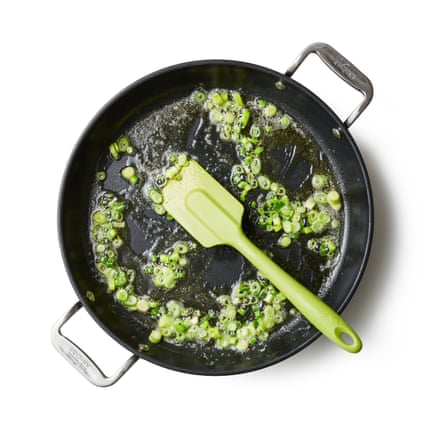
Once the pasta is almost done, melt the butter in a frying pan on a low heat and briefly fry the spring onions until softened.

Pour in the cream, bring to a simmer, then add the lemon zest and juice to taste. Loosen the cream with a little of the pasta cooking water, taste and adjust the seasoning, if necessary, then add the blanched vegetables and toss to coat.
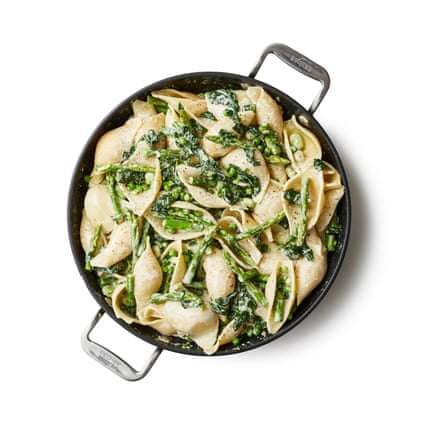
Drain the pasta well, add to the pan and toss until it’s all coated with sauce. Scatter over the roughly torn mint and basil leaves, divide between plates, top liberally with the toasted pine nuts and grated cheese, and serve.
Pasta primavera: which ingredients sing of spring to you (and are you lucky enough to have morels to add?)? And does anyone have any memories of the dish in its heyday, prepared tableside at Le Cirque or elsewhere?
"food recipes" - Google News
May 03, 2023 at 06:05PM
https://ift.tt/LHkjuM0
How to make the perfect pasta primavera – recipe - The Guardian
"food recipes" - Google News
https://ift.tt/FzayBZY
https://ift.tt/vhdgWe4
Bagikan Berita Ini















0 Response to "How to make the perfect pasta primavera – recipe - The Guardian"
Post a Comment